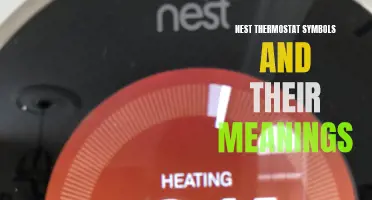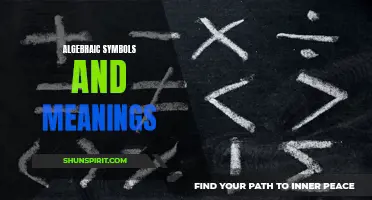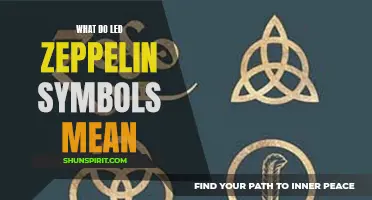
The fist symbol is one that has been used for centuries to convey a sense of unity, power, resilience, and solidarity among individuals and communities. It is a powerful visual representation of strength and determination, often associated with social and political movements aiming to bring about change and fight for justice. From the iconic raised fist of the Black Power movement to the clenched fists of labor unions rallying for workers' rights, this symbol has come to represent the collective voice and resistance of marginalized and oppressed groups. In this article, we will delve deeper into the fist symbol meaning and its significance in different contexts throughout history.
What You'll Learn
- What is the historical significance of the raised fist symbol?
- Can you explain the different meanings associated with the raised fist symbol in different cultures?
- How did the raised fist symbol become associated with protests and activism?
- Are there any specific movements or events that helped popularize the raised fist symbol?
- Is the raised fist symbol still used today and what does it represent in modern contexts?

What is the historical significance of the raised fist symbol?
The raised fist symbol is a powerful and iconic gesture that has been used throughout history to represent various movements and messages. From its origins as a symbol of solidarity and resistance, the raised fist has become synonymous with social and political activism.
The raised fist as a symbol dates back to ancient times, with depictions of clenched fists found in ancient Egyptian and Roman art. However, it was during the 20th century that the raised fist became widely recognized and associated with political movements.
Perhaps the most well-known usage of the raised fist is associated with the Black Power movement of the 1960s and 1970s. The symbol was popularized by the Black Panther Party, a revolutionary socialist organization that fought for civil rights and equality for African Americans. The raised fist became a powerful gesture of solidarity and resistance against racial injustice, symbolizing black strength, unity, and defiance.
During this time, the raised fist also gained prominence in other movements, such as the women's liberation movement and the anti-war movement. Women's rights activists used the symbol as a sign of female empowerment and resistance against gender inequality. Similarly, anti-war protesters adopted the raised fist to signify their opposition to the Vietnam War and the militarization of society.
In recent years, the raised fist has once again gained visibility as a symbol of resistance. It has been used in protests around the world to symbolize various causes, including the fight against police brutality, racial inequality, and social injustice. The image of a raised fist has become a universal symbol of activism and solidarity, transcending language and culture.
The significance of the raised fist lies in its ability to convey a powerful message of unity and resistance. It represents the strength and determination of individuals and communities fighting for their rights and striving for a more just and equal society. The raised fist serves as a reminder of the struggles and triumphs of those who have come before, and a call to action for those who continue to fight for justice.
In conclusion, the raised fist symbol has a rich historical significance as a powerful gesture of solidarity and resistance. From its origins in ancient art to its association with various social and political movements, the raised fist has become an iconic symbol of activism. Its continued use in protests and demonstrations around the world demonstrates its enduring relevance and power as a visual representation of collective resistance against injustice.
The Warrior Symbol: Unveiling the Meaning Behind this Ancient Emblem
You may want to see also

Can you explain the different meanings associated with the raised fist symbol in different cultures?
The raised fist symbol is a powerful and iconic image that has been used by various cultures throughout history to convey different meanings. This symbol, often seen in protests, rallies, and movements for social justice, holds significant connotations in different parts of the world. Here, we will explore its diverse meanings and interpretations across cultures:
Political Activism:
One of the most well-known representations of the raised fist is its association with political activism. Originating in the late 19th century, this symbol has been widely used by socialist and communist movements to symbolize solidarity, resistance against oppression, and the struggle for workers' rights. It is commonly linked to revolutionary figures like Che Guevara and used in protests advocating for class equality and Marxist principles.
Black Power Movement:
In the United States during the 1960s and 1970s, the raised fist symbol gained prominence as a prominent emblem of the Black Power movement. It was popularized by activists like Tommie Smith and John Carlos, who famously raised their fists during the 1968 Olympic Games in Mexico City. The raised fist in this context represents black pride, unity, and the ongoing fight against racial injustice.
Feminism and Women's Rights:
The raised fist has also been adopted as a symbol of feminist activism and the struggle for women's rights. It has been used in campaigns advocating for gender equality, reproductive rights, and an end to violence against women. This usage highlights the strength, resilience, and collective power of women in their fight for justice and equality.
Anti-Apartheid Movement:
During the apartheid era in South Africa, the raised fist symbolized resistance against racial segregation, oppression, and the fight for freedom. It was widely used by organizations like the African National Congress (ANC) and its allies to show solidarity and unity in the face of apartheid policies. The raised fist became a powerful symbol of anti-apartheid activism worldwide.
LGBT+ Activism:
In recent years, the raised fist has also been embraced as a symbol of solidarity within the LGBT+ community. It is used to express resilience, resistance against discrimination, and the demand for equal rights. The raised fist in this context often incorporates rainbow colors, representing the diverse identities within the community.
Indigenous Movements:
The raised fist has been adopted by various indigenous movements worldwide to assert their rights, reclaim their land and resources, and challenge colonialism and systemic injustices. It serves as a symbol of indigenous resistance, empowerment, and the struggle to preserve cultural heritage.
While the raised fist symbol has different meanings across cultures, it consistently represents strength, unity, and resistance against oppression. Its power lies in its ability to transcend language barriers and communicate a shared desire for justice and equality. As it continues to be utilized by various movements and causes, the raised fist serves as a powerful reminder of the ongoing fight for a more just and equitable world.
The Intriguing History and Symbolic Meaning of the Iron Cross
You may want to see also

How did the raised fist symbol become associated with protests and activism?
The raised fist symbol has become closely associated with protests and activism around the world. It has come to symbolize unity, strength, and solidarity in the face of oppression and injustice.
The origins of the raised fist symbol can be traced back to the late 19th and early 20th centuries. It was first used by labor activists and socialists to represent the power of the working class in their struggle for better working conditions and fair wages.
One of the earliest instances of the raised fist symbol being used in a political context occurred during the Russian Revolution of 1917. The Bolsheviks, led by Vladimir Lenin, adopted the raised fist as a symbol of their commitment to overthrowing the bourgeoisie and establishing a socialist society.
In the 1960s and 1970s, during the civil rights movement and anti-war protests in the United States, the raised fist symbol gained further prominence. It was used by groups such as the Black Panther Party and the Students for a Democratic Society to express their resistance to racism, imperialism, and societal inequalities. The raised fist became a powerful visual expression of their demand for justice and equal rights.
One of the most iconic images of the raised fist symbol is the photograph of Tommie Smith and John Carlos, two African American athletes, raising their fists during the medal ceremony at the 1968 Olympic Games in Mexico City. This act of protest, known as the Black Power salute, was a powerful statement against racial discrimination and injustice.
Since then, the raised fist symbol has been adopted by countless social justice movements and activist groups around the world. It has been used to protest against various forms of oppression, including racism, sexism, homophobia, and injustice. The symbol has appeared on banners, signs, and artwork at demonstrations, rallies, and marches across the globe, sending a powerful message of resistance and solidarity.
In recent years, the raised fist symbol has become even more prominent with the rise of social media and the ability to share and spread images globally. The symbol has been embraced by movements such as Black Lives Matter, Women's March, and #MeToo, representing their fight against systemic violence and inequality.
The raised fist symbol has transcended cultural and geographical boundaries, becoming a universal symbol of resistance and solidarity. It continues to inspire and empower individuals and communities to come together and fight for a more just and equitable world.
Decoding the Symbolic Meaning Behind Mitsudomoe
You may want to see also

Are there any specific movements or events that helped popularize the raised fist symbol?
The raised fist symbol has a rich history and has been used by various movements and events over the years to convey different messages of solidarity, power, and resistance. While there is not one specific event that solely popularized the raised fist symbol, there are several noteworthy movements and events that helped bring it into the public eye.
One of the earliest uses of the raised fist symbol can be traced back to the Russian Revolution of 1917. During this time, socialists and workers adopted the raised fist as a symbol of the revolution and resistance against the ruling class. The raised fist represented the unity and strength of the proletariat in their struggle for a fairer society.
In the United States, the raised fist symbol gained popularity during the civil rights movement of the 1960s. African American civil rights activists, such as Martin Luther King Jr., and groups like the Black Panther Party used the raised fist as a powerful gesture of solidarity and defiance against racial inequality and oppression. It became a symbol of black power and liberation.
Another significant event in the popularization of the raised fist symbol was the student protests during the late 1960s and early 1970s. Students protesting against the Vietnam War and demanding social change often raised their fists as a sign of unity and determination. The raised fist became a symbol of the anti-establishment and counterculture movements of the time.
In more recent history, the raised fist symbol has been associated with the global Occupy movement that emerged in 2011. Protesters across the world raised their fists as a way to express their discontent with economic inequality and corporate greed. The raised fist became a unifying symbol for the 99% and a call for social justice and equality.
Additionally, the raised fist symbol has been used by various marginalized communities and activist groups to highlight their specific struggles and fight against discrimination. It has been used during LGBTQ+ pride rallies, feminist marches, and protests against police brutality. The raised fist continues to be a powerful symbol of resistance and solidarity across different social justice movements.
While there are specific movements and events that have played a significant role in popularizing the raised fist symbol, its history goes beyond any one particular event. It has become a universal symbol of strength, unity, and resistance, representing the ongoing fight for equality and justice in the face of oppression.
Decoding the Mysteries: Understanding Guitar Tab Symbols and Their Meanings
You may want to see also

Is the raised fist symbol still used today and what does it represent in modern contexts?
The raised fist symbol is a powerful and iconic image that has been used throughout history to symbolize various movements and causes. While its origins can be traced back to ancient times, the symbol gained significant prominence during the 20th century, particularly during the civil rights and labor movements. Today, the raised fist symbol continues to be utilized in various contexts and carries different meanings depending on the cause it is associated with.
One of the most well-known uses of the raised fist symbol is its association with the Black Power movement, which emerged in the 1960s as a call for African Americans to recognize and embrace their racial identity with pride. The raised fist symbol became a powerful visual representation of Black Power, signifying unity, strength, and resistance against racial oppression. This symbol was widely seen during protests and demonstrations held by the Black Panther Party and other organizations advocating for racial equality.
In the present day, the raised fist symbol continues to be used in the fight against racial injustice and police brutality. It has become a common sight at demonstrations, rallies, and social media campaigns related to the Black Lives Matter movement. The raised fist represents solidarity with Black communities, demanding justice and an end to systemic racism.
The symbol has also been adopted by various other social justice movements. It is often seen at feminist rallies, symbolizing the fight for women's rights, gender equality, and an end to gender-based violence. The raised fist is also utilized by LGBTQ+ activists, representing their struggle for equal rights and acceptance. In these contexts, the symbol serves as a rallying cry for collective action and the empowerment of marginalized communities.
Furthermore, the raised fist symbol has extended beyond the realm of social justice causes and is frequently used as a gesture of resistance against oppressive regimes and authoritarian governments. It has been employed by activists across the globe, from the Arab Spring movements to pro-democracy protests in countries like Hong Kong and Belarus. In such cases, the raised fist represents defiance, courage, and an unwavering commitment to fight for freedom and human rights.
In the age of social media, the raised fist symbol has become even more pervasive. It is commonly used as an emoji on platforms like Twitter and Instagram, allowing users to show support for a range of causes with a simple icon. This virtual form of the symbol enables people to easily express their solidarity and align themselves with different movements and struggles.
In conclusion, the raised fist symbol remains a powerful and widely recognized emblem of resistance, strength, and solidarity. It has evolved over time to represent various social justice causes, from racial equality to women's rights and LGBTQ+ advocacy. The symbol continues to be used in modern contexts to demonstrate unity and defiance against oppression, making it a potent tool for activists and individuals seeking to effect change.
Decoding the Mystical Meanings of the Monas Hieroglyphica Symbol
You may want to see also
Frequently asked questions
The fist symbol is often associated with strength, power, and unity. It has been used throughout history as a symbol of resistance and revolution, representing the fight for social justice and equality. In recent years, it has become closely associated with the Black Lives Matter movement and other social justice movements fighting against systemic racism and injustice.
What is the origin of the fist symbol?
The use of the fist as a symbol of power and resistance dates back to ancient times. It can be found in ancient Egyptian art, where it represents protection and strength. In more modern history, the raised fist was popularized as a symbol of solidarity and unity during the labor movement in the late 19th and early 20th centuries. It gained further prominence during the civil rights movement in the 1960s and has since been adopted by various social and political movements around the world.
What are some variations of the fist symbol?
While the raised fist is the most commonly recognized variation of the fist symbol, there are several other variations that have different meanings. The clenched fist, with the thumb tucked inside the fingers, is often used to represent solidarity and determination. The black fist, also known as the Black Power salute, was popularized by the Black Panther Party and Black Power movement in the 1960s and represents pride, unity, and resistance against oppression. Additionally, there are variations of the fist symbol that incorporate other symbols or elements, such as the fist breaking chains to represent liberation and freedom.







